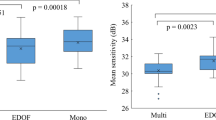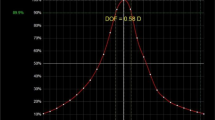Abstract
Background/Objectives
To determine the influence of decentration and tilt of a pseudophakic aspheric intraocular lens (IOL) on visual acuity (VA) and higher-order aberrations (HOAs), and to analyze the agreement between pupil center/axis and iridocorneal angles center/axis when assessing IOL decentration and tilt.
Subjects/Methods
A prospective interventional case series study including thirty-three patients undergoing Tecnis ZCB00 (Abbott Medical Optics) implantation. IOL decentration and tilt with respect to two reference systems (pupil and iridocorneal angles centers/axes), in cartesian (X,Y) and polar (radius/tilt, polar angle/azimuth) coordinates, were assessed with optical coherence tomography. VA and internal and ocular HOAs were evaluated. Multiple linear regression models and intraclass correlation coefficient (ICC) were computed.
Results
IOL decentration only showed a significant effect on internal HOAs for \(Z_3^3\) (R2 = 0.20, P = 0.04). IOL decentration with respect to the pupil center showed a significant effect on ocular \(Z_3^{ - 3}\) (R2 = 0.18, P = 0.05), \(Z_3^1\) (R2 = 0.36, P = 0.001) and \(Z_4^{ - 4}\) (R2 = 0.24, P = 0.02); and with respect to the center of iridocorneal angles, on ocular \(Z_3^3\) (R2 = 0.21, P = 0.03), \(Z_4^2\) (R2 = 0.32, P = 0.003), primary coma (R2 = 0.41, P < 0.001), and coma-like (R2 = 0.40, P = 0.001). Poor agreement between both reference systems was found for IOL decentration measurements (ICC ≤ 0.41), except for the polar angle coordinate (ICC = 0.83). Tilt measurements showed good agreement (ICC ≥ 0.75).
Conclusions
Tecnis ZCB00 decentration and tilt values after uneventful implantation appear not to have influence on VA, and their effect on HOAs are not high enough to clinically affect quality of vision. Pupil and iridocorneal angles used as reference systems may be interchangeable for IOL tilt measurements, but not for decentration.
This is a preview of subscription content, access via your institution
Access options
Subscribe to this journal
Receive 18 print issues and online access
$259.00 per year
only $14.39 per issue
Buy this article
- Purchase on Springer Link
- Instant access to full article PDF
Prices may be subject to local taxes which are calculated during checkout


Similar content being viewed by others
Data availability
The datasets generated during and/or analyzed during the current study are available from the corresponding author on reasonable request.
References
Smith G, Cox MJ, Calver R, Garner LF. The spherical aberration of the crystalline lens of the human eye. Vis Res. 2021;41:235–43.
Amano S, Amano Y, Yamagami S, Miyai T, Miyata K, Samejima T, et al. Age-related changes in corneal and ocular higher-order wavefront aberrations. Am J Ophthalmol. 2004;137:988–92.
Alió JL, Schimchak P, Negri HP, Montés-Micó R. Crystalline lens optical dysfunction through aging. Ophthalmology. 2005;112:2022–9.
Davis G. The evolution of cataract surgery. Mo Med. 2016;113:58–62.
Barbero S, Marcos S, Jiménez-Alfaro I. Optical aberrations of intraocular lenses measured in vivo and in vitro. J Opt Soc Am A Opt Image Sci Vis. 2003;20:1841–51.
Montés-Micó R, Ferrer-Blasco T, Cerviño A. Analysis of the possible benefits of aspheric intraocular lenses: review of the literature. J Cataract Refract Surg. 2009;35:172–81.
Holladay JT, Piers PA, Koranyi G, van der Mooren M, Norrby NES. A new intraocular lens design to reduce spherical aberration of pseudophakic eyes. J Refract Surg. 2002;18:683–91.
Schrecker J, Langenbucher A, Seitz B, Eppig T. First results with a new intraocular lens design for the individual correction of spherical aberration. J Cataract Refract Surg. 2018;44:1211–9.
Schrecker J, Schröder S, Langenbucher A, Seitz B, Eppig T. Individually customized IOL versus standard spherical aberration-correcting IOL. J Refract Surg. 2019;35:565–74.
Mester U, Dillinger P, Anterist N. Impact of a modified optic design on visual function: clinical comparative study. J Cataract Refract Surg. 2003;29:652–60.
Bellucci R, Scialdone A, Buratto L, Morselli S, Chierego C, Criscuoli A, et al. Visual acuity and contrast sensitivity comparison between Tecnis and AcrySof SA60AT intraocular lenses: a multicenter randomized study. J Cataract Refract Surg. 2005;31:712–7.
Trueb PR, Albach C, Montés-Micó R, Ferrer-Blasco T. Visual acuity and contrast sensitivity in eyes implanted with aspheric and spherical intraocular lenses. Ophthalmology. 2009;116:890–5.
Morales EL, Rocha KM, Chalita MR, Nosé W, Avila MP. Comparison of optical aberrations and contrast sensitivity between aspheric and spherical intraocular lenses. J Refract Surg. 2011;27:723–8.
Schuster AK, Tesarz J, Vossmerbaeumer U. The impact on vision of aspheric to spherical monofocal intraocular lenses in cataract surgery: a systematic review with meta-analysis. Ophthalmology. 2013;120:2166–75.
Pérez-Gracia J, Varea A, Ares J, Vallés JA, Remón L. Evaluation of the optical performance for aspheric intraocular lenses in relation with tilt and decenter errors. PLoS One. 2020;15:e0232546.
Mamalis N, Brubaker J, Davis D, Espandar L, Werner L. Complications of foldable intraocular lenses requiring explantation or secondary intervention-−2007 survey update. J Cataract Refract Surg. 2008;34:1584–91.
Fujikado T, Saika M. Evaluation of actual retinal images produced by misaligned aspheric intraocular lenses in a model eye. Clin Ophthalmol. 2014;8:2415–23.
Pérez-Merino P, Marcos S. Effect of intraocular lens decentration on image quality tested in a custom model eye. J Cataract Refract Surg. 2018;44:889–96.
Lawu T, Mukai K, Matsushima H, Senoo T. Effects of decentration and tilt on the optical performance of 6 aspheric intraocular lens designs in a model eye. J Cataract Refract Surg. 2019;45:662–8.
Ashena Z, Maqsood S, Ahmed SN, Nanavaty MA. Effect of intraocular lens tilt and decentration on visual acuity, dysphotopsia and wavefront aberrations. Vision. 2020;14:41.
Cohen J. Statistical power analysis of the behavioural sciences. 2nd ed. New York: Academic Press; 1988.
Koo TK, Li MY. A guideline of selecting and reporting intraclass correlation coefficients for reliability research. J Chiropr Med. 2016;15:155–63.
Song WK, Lee JA, Kim JY, Kim MJ, Tchah H. Analysis of positional relationships of various centers in cataract surgery. Korean J Ophthalmol. 2019;33:70–81.
Song IS, Kim MJ, Yoon SY, Kim JY, Tchah H. Higher-order aberrations associated with better near visual acuity in eyes with aspheric monofocal IOLs. J Refract Surg. 2014;30:442–6.
Petermeier K, Frank C, Gekeler F, Spitzer MS, Messias A, Szurman P. Influence of the pupil size on visual quality and spherical aberration after implantation of the Tecnis 1-piece intraocular lens. Br J Ophthalmol. 2011;95:42–45.
Fernández-Sánchez V, Ponce ME, Lara F, Montés-Micó R, Castejón-Mochón JF, López-Gil N. Effect of 3rd-order aberrations on human vision. J Cataract Refract Surg. 2008;34:1339–44.
Yu F, Chang P, Li J, Zhou Y, Zhao Y. Comparative study of the tilt, decentration and higher-order aberrations (HOA) of single-piece and 3-piece tecnis aspheric intraocular lenses. Zhonghua Yan Ke Za Zhi. 2015;51:270–5.
Piers PA, Weeber HA, Artal P, Norrby S. Theoretical comparison of aberration-correcting customized and aspheric intraocular lenses. J Refract Surg. 2007;23:374–84.
Baumeister M, Bühren J, Kohnen T. Tilt and decentration of spherical and aspheric intraocular lenses: effect on higher-order aberrations. J Cataract Refract Surg. 2009;35:1006–12.
Miyata K, Kataoka Y, Matsunaga J, Honbo M, Minami K. Prospective comparison of one-piece and three-piece tecnis aspheric intraocular lenses: 1-year stability and its effect on visual function. Curr Eye Res. 2015;40:930–5.
Tekin K, Sekeroglu MA, Kiziltoprak H, Doguizi S, Inanc M, Yilmazbas P. Static and dynamic pupillometry data of healthy individuals. Clin Exp Optom. 2018;101:659–65.
Funding
EM-P was supported by Junta de Castilla y León and European Social Fund (EDU/1100/2017). The funders of the study had no role in study design, data collection, data analysis, data interpretation, or writing of the report.
Author information
Authors and Affiliations
Contributions
Concept and design: EP, NEH, PJB. Acquisition, analysis, or interpretation of data: All authors. Methodological development and statistical analysis: EMP, EP, AJAC, ALR. Drafting of the paper: EMP, ALR, ALM, MJM. Critical revision of the paper for important intellectual content: All authors.
Corresponding author
Ethics declarations
Competing interests
PJB reports grants from Bausch and Lomb, Zeiss and Medicontur outside the scope of the submitted work. The rest of the authors declare no competing interests.
Additional information
Publisher’s note Springer Nature remains neutral with regard to jurisdictional claims in published maps and institutional affiliations.
Supplementary information
Rights and permissions
Springer Nature or its licensor holds exclusive rights to this article under a publishing agreement with the author(s) or other rightsholder(s); author self-archiving of the accepted manuscript version of this article is solely governed by the terms of such publishing agreement and applicable law.
About this article
Cite this article
Martínez-Plaza, E., López-de la Rosa, A., Papadatou, E. et al. Influence of decentration and tilt of Tecnis ZCB00 on visual acuity and higher order aberrations. Eye 37, 1640–1645 (2023). https://doi.org/10.1038/s41433-022-02211-2
Received:
Revised:
Accepted:
Published:
Issue Date:
DOI: https://doi.org/10.1038/s41433-022-02211-2
This article is cited by
-
Influence of decentration of plate-haptic toric intraocular lens on postoperative visual quality
BMC Ophthalmology (2023)



